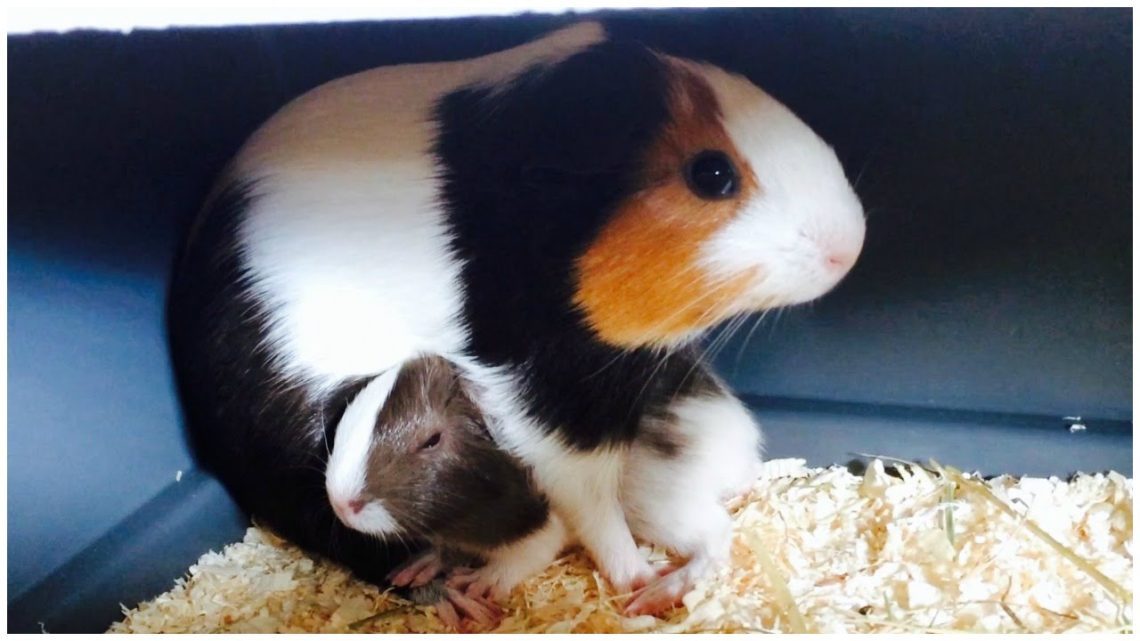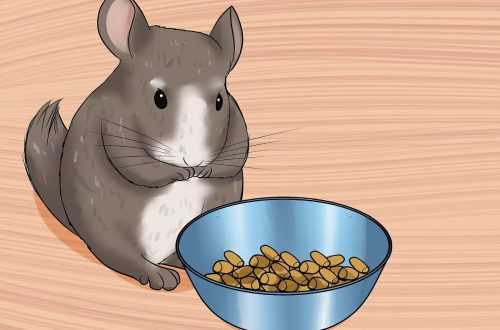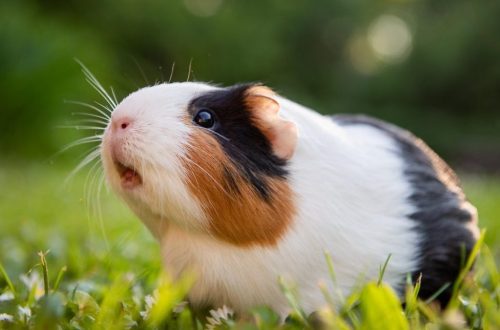
ਇੱਕ ਗਿੰਨੀ ਪਿਗ ਨੂੰ ਜਨਮ ਦੇਣਾ
It is difficult to determine exactly when the female will go into labor. Many people show no signs of anxiety about this event, while others await the birth of piglets with trembling anticipation. Some wait impatiently for weeks for the female to give birth. For such people, knowing the exact date of mating of animals is of great value. You can give the date of conception with some certainty if you have seen the pigs mate or if the pig was covered immediately after birth (the day the piglets were born will be considered the first day of the next pregnancy). But sometimes you can wait 66-72 days after coverage and find that conception most likely did not occur because labor never began. If the pig feels well and eats normally, you should not panic and run to the veterinarian and report that the pig is about to give birth, thereby provoking him to such harmful actions as artificial induction of labor or caesarean section. For most gilts not yet ready to give birth, this will mean death – for themselves and for the cubs.
The opening of the birth canal and the expansion of the pelvic area (see the article “Signs of Pregnancy in Guinea Pigs” is the surest sign of an impending birth. If the birth canal is open by 1-2 fingers (depending on the size of the fingers), you can most likely expect the birth of piglets in within the next 48 hours.However, there are exceptions, so consider this indicator as a useful clue, and not “hard evidence”.The membrane that covers the vagina between estrus and during pregnancy disappears before delivery, but this fact will not help determine the exact date of delivery , since the time of membrane disappearance varies greatly.
In the last few hours before giving birth, the female becomes less active, her appetite may decrease (but not completely disappear). However, the pig should have bright, clean eyes and a normal coat, and if you offer her her favorite treat, she will eat it with pleasure. I have read and heard that gilts empty their rectum hours before giving birth, and so a pile of litter in the corner should indicate an upcoming birth. However, this requires daily cleaning and brushing, and to be honest, I have not found this forecasting method to be completely reliable.
Usually, childbirth occurs at the quietest time. There are different opinions about when the birth of piglets mainly occurs – during the day or at night. Through intense observation I have found that gilts prefer the early morning, but just as often I have noticed the onset of labor during the morning feeding or cleaning the cage, and as the gilts are already accustomed to this daily exercise, they did not pay any attention to me. However, it should be remembered that pigs do not like excessive noise and anxiety from others, especially if the females are inexperienced and do not yet know what is happening to their body.
It is difficult to determine exactly when the female will go into labor. Many people show no signs of anxiety about this event, while others await the birth of piglets with trembling anticipation. Some wait impatiently for weeks for the female to give birth. For such people, knowing the exact date of mating of animals is of great value. You can give the date of conception with some certainty if you have seen the pigs mate or if the pig was covered immediately after birth (the day the piglets were born will be considered the first day of the next pregnancy). But sometimes you can wait 66-72 days after coverage and find that conception most likely did not occur because labor never began. If the pig feels well and eats normally, you should not panic and run to the veterinarian and report that the pig is about to give birth, thereby provoking him to such harmful actions as artificial induction of labor or caesarean section. For most gilts not yet ready to give birth, this will mean death – for themselves and for the cubs.
The opening of the birth canal and the expansion of the pelvic area (see the article “Signs of Pregnancy in Guinea Pigs” is the surest sign of an impending birth. If the birth canal is open by 1-2 fingers (depending on the size of the fingers), you can most likely expect the birth of piglets in within the next 48 hours.However, there are exceptions, so consider this indicator as a useful clue, and not “hard evidence”.The membrane that covers the vagina between estrus and during pregnancy disappears before delivery, but this fact will not help determine the exact date of delivery , since the time of membrane disappearance varies greatly.
In the last few hours before giving birth, the female becomes less active, her appetite may decrease (but not completely disappear). However, the pig should have bright, clean eyes and a normal coat, and if you offer her her favorite treat, she will eat it with pleasure. I have read and heard that gilts empty their rectum hours before giving birth, and so a pile of litter in the corner should indicate an upcoming birth. However, this requires daily cleaning and brushing, and to be honest, I have not found this forecasting method to be completely reliable.
Usually, childbirth occurs at the quietest time. There are different opinions about when the birth of piglets mainly occurs – during the day or at night. Through intense observation I have found that gilts prefer the early morning, but just as often I have noticed the onset of labor during the morning feeding or cleaning the cage, and as the gilts are already accustomed to this daily exercise, they did not pay any attention to me. However, it should be remembered that pigs do not like excessive noise and anxiety from others, especially if the females are inexperienced and do not yet know what is happening to their body.
A normal birth is devoid of any drama and blood and usually lasts on the order of 30 minutes or less depending on the number of babies. Many females are silent during childbirth, some make a few plaintive sounds before the birth of the first cub. A piglet is born after several labor pains. Unlike most mammals, female guinea pigs give birth to piglets in a sort of sitting posture, where the calf glides back away from the head.
During normal labor, the mumps sits ruffled. During contractions and attempts, she bends and pulls the cub out of the birth canal with her teeth. The female quickly removes the fetal membrane from the head of the piglet with her teeth, thus allowing him to take his first breath. After that, the female gnaws through the umbilical cord, and then licks the cub from head to toe until it is clean and dry. After a short period of time, the next piglet is born. If the offspring are large, the young may be born at very short intervals. A female who has not given birth before may be so confused that she will not be able to lick one or more of the babies, as a result of which they will be found dead in an intact fetal membrane or dead from the cold if the mother fails to dry and take care of such a large number of babies. In litters with 5 or more piglets, it is very common to find that 1 or 2 of them are dead. If the female does not have time to lick the cub, it is necessary to wrap the newborn in a towel and, gently massaging, carefully release it from the membranes and mucus. Particular care must be taken in the area around the eyes, because. in newborn pigs they are open and there is a risk of damage to the cornea. A dry cub should be put to the female. If the female herself has not gnawed through the umbilical cord, then it is necessary to cut it with sterile scissors at a small distance from the abdomen, but not too close.
The placentas (one for each calf) that come out after birth are eaten in whole or in part by the female, which is very important because they are high in the hormone oxytocin, which causes milk to flow and contracts the uterus, which helps stop bleeding. Many females lick and clean their piglets so thoroughly that there is no trace of blood or anything left after birth. Some pigs sometimes overdo it, so that they damage the ears of the cubs during licking, which, naturally, puts an end to the show career of piglets. And some females even try to eat dead pups, so sometimes you can find badly damaged bodies of piglets, for example, with a bitten off paw. The sight is unpleasant, but it only proves the fact that pigs in nature are absolutely defenseless and try to destroy everything that can give out their location to predators by smell.
Sometimes the birth process can stop for several hours, and then continue normally. However, such interrupted labor is quite dangerous, as a result of which close monitoring of the female is necessary to make sure that everything is in order. Shortly after the end of the birth, the female will start eating again, and the piglets will crowd under her, patiently waiting for their portion of milk. Since the female has only two nipples, patience is essential for piglets. The female should look healthy and feel hungry, although she may also feel tired. Most females are caring mothers, devoting themselves to feeding and caring for their babies. Quite often, one can observe an idyllic picture when the mother lies in the corner of the cage, surrounded by sleeping or sucking piglets. However, sometimes things don’t go as smoothly as described above.
© Mette Lybek Jensen
© Elena Lyubimtseva ਦੁਆਰਾ ਅਨੁਵਾਦ
A normal birth is devoid of any drama and blood and usually lasts on the order of 30 minutes or less depending on the number of babies. Many females are silent during childbirth, some make a few plaintive sounds before the birth of the first cub. A piglet is born after several labor pains. Unlike most mammals, female guinea pigs give birth to piglets in a sort of sitting posture, where the calf glides back away from the head.
During normal labor, the mumps sits ruffled. During contractions and attempts, she bends and pulls the cub out of the birth canal with her teeth. The female quickly removes the fetal membrane from the head of the piglet with her teeth, thus allowing him to take his first breath. After that, the female gnaws through the umbilical cord, and then licks the cub from head to toe until it is clean and dry. After a short period of time, the next piglet is born. If the offspring are large, the young may be born at very short intervals. A female who has not given birth before may be so confused that she will not be able to lick one or more of the babies, as a result of which they will be found dead in an intact fetal membrane or dead from the cold if the mother fails to dry and take care of such a large number of babies. In litters with 5 or more piglets, it is very common to find that 1 or 2 of them are dead. If the female does not have time to lick the cub, it is necessary to wrap the newborn in a towel and, gently massaging, carefully release it from the membranes and mucus. Particular care must be taken in the area around the eyes, because. in newborn pigs they are open and there is a risk of damage to the cornea. A dry cub should be put to the female. If the female herself has not gnawed through the umbilical cord, then it is necessary to cut it with sterile scissors at a small distance from the abdomen, but not too close.
The placentas (one for each calf) that come out after birth are eaten in whole or in part by the female, which is very important because they are high in the hormone oxytocin, which causes milk to flow and contracts the uterus, which helps stop bleeding. Many females lick and clean their piglets so thoroughly that there is no trace of blood or anything left after birth. Some pigs sometimes overdo it, so that they damage the ears of the cubs during licking, which, naturally, puts an end to the show career of piglets. And some females even try to eat dead pups, so sometimes you can find badly damaged bodies of piglets, for example, with a bitten off paw. The sight is unpleasant, but it only proves the fact that pigs in nature are absolutely defenseless and try to destroy everything that can give out their location to predators by smell.
Sometimes the birth process can stop for several hours, and then continue normally. However, such interrupted labor is quite dangerous, as a result of which close monitoring of the female is necessary to make sure that everything is in order. Shortly after the end of the birth, the female will start eating again, and the piglets will crowd under her, patiently waiting for their portion of milk. Since the female has only two nipples, patience is essential for piglets. The female should look healthy and feel hungry, although she may also feel tired. Most females are caring mothers, devoting themselves to feeding and caring for their babies. Quite often, one can observe an idyllic picture when the mother lies in the corner of the cage, surrounded by sleeping or sucking piglets. However, sometimes things don’t go as smoothly as described above.
© Mette Lybek Jensen
© Elena Lyubimtseva ਦੁਆਰਾ ਅਨੁਵਾਦ





